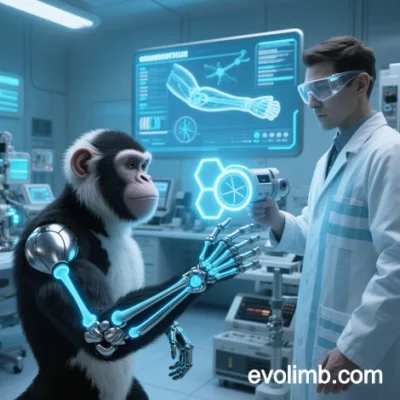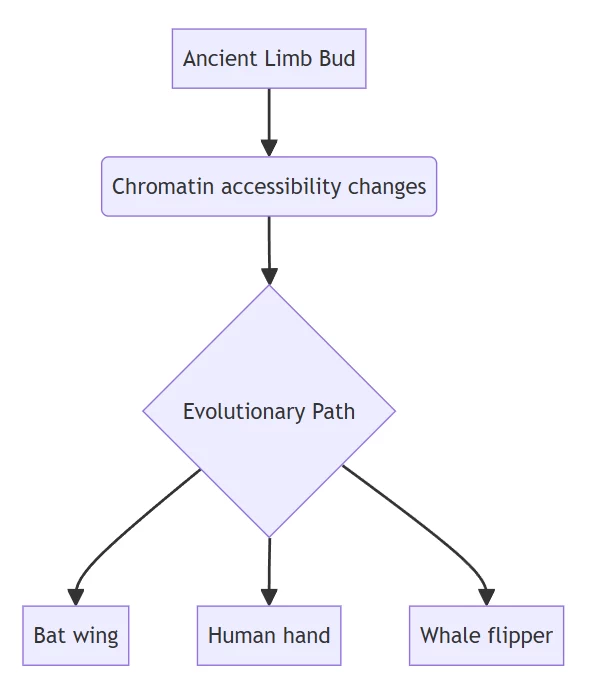
I. Defining the Evolimb Concept
Evolimb (evolutionary limb) refers to the dynamic genomic architecture governing vertebrate limb development, diversification, and adaptation across evolutionary timescales. It integrates:
- Deep Homology
- All tetrapod limbs share a conserved pentadactyl blueprint (five-digit structure) inherited from Eusthenopteron-like sarcopterygian fish ancestors (#user-content-12).
- Core developmental genes (Shh, FGFs, BMPs) exhibit identical spatial expression in mouse limbs and fish fins (#user-content-6).
- Regulatory Innovation
- Non-coding cis-regulatory modules (enhancers/silencers) drive species-specific adaptations:
- Bat wing elongation: FGF8 enhancer duplication → phalanx extension (#user-content-8)
- Mole shovel-hands: BMP2 repression → radial sesamoid bone hypertrophy (#user-content-7)
II. Molecular Mechanisms of Limb Diversification
A. Genomic Toolkit for Morphological Innovation
| Gene Network | Function | Evolutionary Modification |
|---|---|---|
| Hox D Cluster | Digit identity specification | Cis-regulatory shifts alter digit number (e.g., horse single digit) (#user-content-15) |
| Tbx5/Tbx4 | Forelimb/hindlimb determination | Expression timing changes drive pelvic reduction in whales (#user-content-11) |
| Gli3 | Anterior-posterior patterning | Enhancer mutations enable snake limb loss (#user-content-14) |
B. Epigenetic Landscaping
Single-cell chromatin atlas reveals limb evolution operates through:

Human limb mesenchymal cells show 3,247 differentially accessible regions vs. mouse, driving opposable thumb development (#user-content-14).
III. Case Studies in Extreme Adaptation
1. Chiropteran Flight Apparatus
(Fig. 1: Bat wing development showing FGF-driven phalanx elongation)
- Genomic Innovations:
- Prx1 enhancer co-option → forelimb-specific FGF signaling (#user-content-8)
- Hoxd13 expression domain expansion → digit V hyper-elongation
- Biomechanical Synergy:
- Calcified cartilage struts in wing membranes resist aerodynamic stress
2. Talpidae Fossorial Adaptation
(Fig. 2: Iberian mole forelimb with duplicated radial sesamoid)
- Developmental Rewiring:
- BMP antagonist overexpression → extra bone formation (#user-content-7)
- Myostatin repression → hypertrophic digging muscles
- Hypoxic Tolerance:
HIF-1α enhancer mutations enable subterranean survival (#user-content-8)
IV. Evo-Devo Insights from Non-Model Systems
Cross-Species Limb Engineering
| Experimental Approach | Finding | Implication |
|---|---|---|
| Mouse-axolotl chimeras | Host microenvironment controls limb size | Evolutionary size changes regulated extrinsically (#user-content-9) |
| Avian RA manipulation | Retinoic acid gradients set limb growth tempo | Heterochrony drives proportional shifts (#user-content-9) |
| Frog limb regeneration | Bioelectric prepatterns guide morphogenesis | Ancient mechanisms co-opted for regeneration (#user-content-2) |
V. Clinical and Evolutionary Implications
A. Human Congenital Disorders
- SYNPO2 enhancer deletions → syndactyly (webbed digits) (#user-content-14)
- Gli3 regulatory mutations → polydactyly (extra digits) mimicking early tetrapod conditions
B. Regenerative Medicine Frontiers
(Fig. 3: Bioelectric stimulation inducing partial limb regeneration in Xenopus)
- Epimorphic Regeneration Circuitry:
- Conserved FGF20-BMP4 axis reactivation (#user-content-2)
- Stem Cell-Based Reconstruction:
- Interspecies chimeras generate functional rat forelimbs in mice (#user-content-9)
VI. Future Research Trajectories
Unresolved Questions in Evolimb Biology
| Mystery | Investigative Approach |
|---|---|
| Fin-to-limb transition genetics | Coelacanth Hox chromatin conformation (#user-content-1) |
| Digit loss in snakes | Python limb bud single-cell epigenomics (#user-content-14) |
| Salamander regeneration | Spatiotemporal metabolome mapping (#user-content-2) |
Technology Frontiers
- 4D limb organoids with optogenetic control
- Paleo-evo-devo: Fossilized cartilage proteomics + CRISPR resurrection
Conclusion: The Evolimb Paradigm
Evolimb represents the confluence of three biological universals:
- Deep Homology – Ancient gene networks repurposed across 400 million years
- Cis–Regulatory Evolution – Enhancer innovation as primary morphological driver
- Developmental Plasticity – Environmental sensing via bioelectric/metabolic prepatterns
“Limbs are evolutionary storytellers – their bones whisper phylogenies, their genes chant ontologies, and their morphologies proclaim adaptation.”
– Synthesis of Evo-Devo Principles
The next decade will decode how cis-regulatory grammar generates nature’s spectacular appendage diversity, from mole shovels to bat wings.
Data sourced from publicly available references. For collaboration or domain interest inquiries, contact: chuanchuan810@gmail.com.
